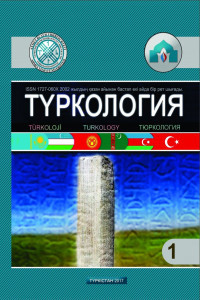JEST VE MİMİK SEMANTİĞİ
SEMANTICS OF MIMIC AND GESTURE
Significant, Concept, Semantic, Expression, Gesture, Proxemics, Communication,
___
- 1. Николаева Т.М. Интерференция языковых и неязыковых коммуникативных средств в человеческом общении. – М.: Высшая школа, 1973. – 79 с.
- 2. Ешимов М.П. Ым семантикасы: универсалды және ұлттық табиғаты: Филол. ғыл. канд. дис.: 10.02.02. – Алматы, 2004. – 127 б.
- 3. Бейсембаева С.Б. Невербальные компоненты коммуникации в казахском языке: Дис. канд. филол. наук: 10.02.02. – Алматы: КазНУ, 2003. – 119 с.
- 4. Галичев А.И. Кинесический и проксемический компоненты речевого общения. – М.: Наука, 1987. – 122 с.
- 5. Хайдеметс М. Пространственный фактор в межличностных отношениях // Человек, среда, пространство. – Тарту: Изд. Тартусского унив., 1979. – С. 120-135.
- 6. Бгажноков Б.Х. Очерки этнографии адыгов. – Нальчик: Эльбрус, 1983. – 229 с.
- 7. Звегинцев М. Семасиология. М.: Изд-во МГУ, 1957. – 321 с.
- 8. Фомина К. Современный русский язык // Лексикология. – Москва: Наука, 1984. – 167 с.
- 9. Мұсабаев Ғ. Қазіргі қазақ тілі // Лексикология. – Алматы: Ғылым, 1973. – 362 б.
- 10. Эрсиласун, Ахмет Б. (2009), «Современное состояние и проблемы изучения турецкого языка», Журнал тюркских исследований Гази, Специальный выпуск Нечмеддина Хачиеминоглу, выпуск 5, (с.149), с. 143-156.
- 11. Оразов М. Қазақ тілінің семантикасы. – Алматы: Рауан, 1991. – 213 б.
- 12. Болғанбаев Ә. Қазақ тілі лексикологиясы. – Алматы: Мектеп, 1988. –147 б.
- 13. Салкинбаева А. Семантика и функция имени действия на –у в современном казахском языке: Дис. канд. филол. наук: 10.02.02. – КазНУ, 1991. – 116 с.
- 14. Сағындықұлы Б. Қазіргі қазақ тілі // Лексикология. – Алматы: Қазақ университеті, 2004. – 192 б.
- 15. Момынова Б. Газет лексикасы: Жүйесі мен құрылымы. – Алматы: Арыс, 1999. – 224 б.
- ISSN: 1727-060X
- Başlangıç: 2002
- Yayıncı: Hoca Ahmet Yesevi Uluslararası Türk-Kazak Üniversitesi
DEŞT-İ KIPÇAK, ALTIN ORDU VE ORTA ASYA TARİHİNDEKİ DOĞU MAGYARLAR
IGNÁC KÚNOS’UN ANADOLU HALK EDEBİYATINA VE DİLBİLİMİNE KATKILARI
KUMUK ÇOCUK ŞİİRİNDE HAYVAN İMGELERİ
YESEVİ'NİN YOLU VE YARATTIĞI ÖĞRETİ
MEVLÂNÂ VE ŞAL AKIN’IN ESERLERINDE “NEFS” KAVRAMI İÇİN KULLANILAN METAFORLARIN KARŞILAŞTIRILMASI
YURTDIŞINDAN GÖÇEN KAZAKLARIN DİLİNDEKİ ÜNSÜZLERİN DEĞİŞMESİ
TÜRK GİYİM-KUŞAM VE SÜSLENME KÜLTÜRÜNÜN TÜRKÜ VE MAHNI METİNLERİNDEKİ YANSIMALARI
